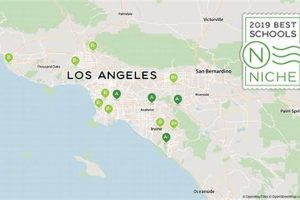Top-tier institutions specializing in musical pedagogy offer comprehensive training for aspiring musicians, educators, and scholars. These programs typically encompass performance, music theory, composition, music history, and pedagogical techniques. A curriculum might include conducting, arranging, and specialized instruction in various instruments or vocal performance. For example, a student focusing on orchestral conducting would receive advanced training in score reading, rehearsal techniques, and baton technique, alongside studies in music history and theory.
High-quality music education programs cultivate well-rounded musicians equipped with the skills and knowledge necessary to thrive in diverse musical landscapes. Graduates are prepared for careers in performance, teaching at various levels, conducting, composing, and music scholarship. Historically, formal institutions dedicated to music education emerged from conservatories and universities seeking to standardize and elevate musical training. This evolution reflects a growing recognition of the importance of structured musical study and its impact on individuals and society.
The following sections will explore various factors to consider when evaluating institutions for musical training, including faculty expertise, available resources, curriculum depth, and career support services. Additionally, the discussion will delve into the evolving landscape of music education and its adaptation to contemporary trends in music and technology.
Tips for Selecting a Top Music Program
Choosing the right institution for advanced musical study is a crucial decision. The following tips offer guidance for navigating this complex process.
Tip 1: Faculty Expertise: Thoroughly research the faculty’s credentials, performance experience, and scholarly contributions. Seek programs with instructors recognized for their expertise in specific areas of interest, such as historical performance practice or jazz improvisation.
Tip 2: Curriculum Depth: Examine the curriculum for breadth and depth, ensuring it aligns with individual career goals. Consider whether the program offers specialized tracks or concentrations in desired areas like music therapy or composition.
Tip 3: Performance Opportunities: Evaluate the availability of performance ensembles, masterclasses, and opportunities for solo performances. Access to high-quality performance venues and experienced conductors can significantly enhance practical training.
Tip 4: Resources and Facilities: Assess the institution’s resources, including practice rooms, recording studios, libraries, and instrument collections. Access to state-of-the-art equipment and comprehensive music libraries is essential for a well-rounded education.
Tip 5: Alumni Network and Career Support: Investigate the institution’s alumni network and career services offerings. A strong alumni network and dedicated career advisors can provide valuable support for post-graduate opportunities.
Tip 6: Institutional Reputation and Accreditation: Consider the institution’s overall reputation and accreditation status. Accreditation ensures that the program meets established standards of quality and rigor.
Tip 7: Location and Environment: Reflect on the institution’s location and its surrounding musical environment. Proximity to professional orchestras, opera houses, and other musical venues can enrich the learning experience.
Careful consideration of these factors will contribute to a well-informed decision, ultimately leading to a fulfilling and successful musical career.
By focusing on these key areas, aspiring musicians can identify institutions best suited to their individual needs and aspirations. The subsequent conclusion will reiterate the importance of thoughtful planning in pursuing advanced musical study.
1. World-class Faculty
Exceptional faculty represents a cornerstone of any top-tier music education program. The presence of accomplished professionals directly influences the quality of instruction, research opportunities, and overall learning environment. This section explores the multifaceted contributions of world-class faculty to leading music institutions.
- Mentorship and Individualized Instruction:
Distinguished faculty members provide personalized guidance, fostering individual student growth. Mentors offer insights gleaned from extensive professional experience, helping students refine their technical skills and artistic sensibilities. This individualized attention is crucial for nurturing talent and preparing students for the demands of professional music careers.
- Advanced Pedagogical Approaches:
Leading music educators often develop innovative pedagogical techniques informed by current research and performance practice. They incorporate cutting-edge methodologies into their teaching, equipping students with the latest tools and knowledge in their respective fields. This commitment to pedagogical advancement ensures graduates receive relevant and contemporary training.
- Professional Networks and Performance Opportunities:
Established faculty often maintain extensive professional networks within the music industry. These connections can create valuable opportunities for students, such as masterclasses with renowned musicians, internships with leading orchestras, and invitations to prestigious festivals. Access to these networks significantly enhances students’ career prospects.
- Research and Scholarly Contributions:
Prominent faculty members contribute to the field through ongoing research and scholarly publications. This active engagement with current musical scholarship enriches the intellectual environment of the institution. Students benefit from exposure to cutting-edge research, fostering critical thinking and contributing to the advancement of musical knowledge.
The collective expertise and influence of world-class faculty significantly elevate a music education program. Their contributions extend beyond the classroom, shaping the overall institutional culture and fostering an environment conducive to artistic excellence and professional success. The presence of distinguished faculty distinguishes leading music schools from their peers, demonstrating a commitment to providing students with unparalleled educational opportunities.
2. Comprehensive Curriculum
A comprehensive curriculum distinguishes top music education institutions, providing students with a well-rounded foundation for diverse musical pursuits. This breadth of training ensures graduates possess the skills and knowledge necessary to navigate the complex and evolving landscape of the music profession. The curriculums structure directly impacts a students ability to integrate theoretical understanding with practical application, fostering both artistry and professional competence.
A hallmark of a comprehensive music curriculum is the integration of core musical disciplines: performance, music theory, music history, and composition. For example, a student specializing in piano performance benefits from studies in music theory, enhancing analytical skills crucial for interpretation. Similarly, a composition student gains practical experience through performance, deepening their understanding of musical expression. Institutions offering robust programs in music technology, conducting, or music business further demonstrate a commitment to comprehensive education, preparing students for a wider range of career paths. The Juilliard School, renowned for its comprehensive approach, integrates performance, theory, and history, fostering well-rounded musicians capable of excelling in diverse professional settings.
The benefits of a comprehensive curriculum extend beyond technical proficiency. Exposure to diverse musical genres and historical periods fosters critical thinking and broadens artistic perspectives. Students develop a deeper understanding of music’s cultural and historical context, enriching their interpretations and compositions. This holistic approach cultivates adaptable musicians capable of contributing to the evolving musical landscape. Furthermore, a comprehensive curriculum equips students with the skills to navigate the multifaceted demands of the music profession, whether pursuing performance, composition, teaching, or research. The ability to integrate theoretical knowledge with practical skills distinguishes graduates of comprehensive programs, positioning them for success in a competitive field. Ultimately, a comprehensive curriculum serves as a cornerstone of best music education schools, nurturing well-rounded musicians prepared for the challenges and opportunities of a dynamic musical world.
3. Cutting-Edge Resources
Access to cutting-edge resources significantly distinguishes top music education institutions. These resources provide students with unparalleled opportunities to develop their skills, explore new artistic avenues, and prepare for the demands of the professional music world. State-of-the-art facilities and equipment are essential for honing technical proficiency and fostering creative exploration. The availability of these resources directly impacts the quality of education and the overall learning experience.
- State-of-the-art Recording Studios:
Professional-grade recording studios provide invaluable hands-on experience with industry-standard equipment and software. Students gain practical skills in recording, mixing, and mastering, essential for musicians in the 21st century. Institutions like Berklee College of Music are renowned for their advanced recording facilities, enabling students to produce high-quality recordings and develop expertise in audio engineering.
- Performance Venues and Technological Integration:
Modern performance spaces equipped with advanced lighting, sound systems, and multimedia capabilities enhance the quality of performances and presentations. Integration of technology in performance allows students to explore new forms of artistic expression. The use of interactive software and projection mapping in venues such as the Walt Disney Concert Hall exemplifies this innovative approach, providing students with exposure to cutting-edge performance technologies.
- Digital Audio Workstations and Software:
Access to advanced digital audio workstations (DAWs) and music notation software equips students with essential tools for composing, arranging, and producing music. These resources facilitate creative exploration and provide a platform for experimenting with different musical styles and techniques. Institutions providing access to industry-standard software, such as Sibelius and Pro Tools, empower students to develop professional-level skills in music production.
- Extensive Music Libraries and Archives:
Comprehensive music libraries and archives, including digital databases and rare manuscript collections, provide invaluable resources for research and scholarly inquiry. Access to these resources broadens students understanding of music history and theory, enriching their artistic development. Institutions like the Eastman School of Music maintain extensive libraries, providing students with access to a wealth of musical scholarship and historical documents.
The availability of cutting-edge resources significantly contributes to the overall quality and reputation of a music education institution. These resources not only enhance technical skills but also foster creativity, innovation, and scholarly inquiry. Access to state-of-the-art facilities, equipment, and digital resources distinguishes leading music schools, preparing students for successful and fulfilling careers in a rapidly evolving musical landscape.
4. Vibrant Performance Opportunities
A hallmark of leading music education institutions is the provision of vibrant performance opportunities. These experiences are essential for developing artistry, building confidence, and preparing students for the rigors of professional music careers. Frequent performance in diverse settings allows students to hone their skills, refine their interpretive abilities, and cultivate a professional stage presence. The quality and variety of performance opportunities directly correlate with the overall educational experience and the preparation students receive for successful careers in music.
- Diverse Ensembles and Performance Platforms:
Top music schools offer a wide range of ensembles, including orchestras, choirs, chamber groups, jazz bands, and opera productions. This diversity allows students to explore various musical styles and develop specialized skills within different ensemble settings. Furthermore, access to varied performance platforms, from intimate recital halls to large concert stages, provides crucial experience adapting to different acoustic environments and audience dynamics. The New England Conservatory, for example, offers numerous ensemble options, providing students with diverse performance experiences crucial for professional development.
- Masterclasses and Workshops with Renowned Artists:
Regular masterclasses and workshops with internationally acclaimed musicians provide invaluable learning opportunities. These sessions offer personalized feedback, insights into professional performance practices, and exposure to diverse artistic perspectives. The opportunity to perform for and receive guidance from established professionals significantly enhances students’ technical skills and artistic development. Institutions such as the Curtis Institute of Music regularly host masterclasses with leading musicians, enriching the educational experience for their students.
- Competitive Performance Opportunities and Festivals:
Participation in competitions and festivals provides students with valuable experience in high-pressure performance environments. These events offer opportunities to showcase their talents to wider audiences, receive adjudication from esteemed professionals, and network with peers from other institutions. Successful participation in prestigious competitions, such as the Tchaikovsky International Competition, can significantly enhance a musician’s career trajectory.
- Community Engagement and Outreach Programs:
Many top music schools encourage community engagement through outreach programs and performances in diverse community settings. These experiences provide students with opportunities to share their music with broader audiences, develop communication skills, and cultivate a sense of social responsibility as artists. Engaging with local communities through music education initiatives or performances at community centers broadens students’ understanding of music’s social impact and fosters a sense of civic engagement.
Vibrant performance opportunities are integral to the educational experience at leading music institutions. These experiences cultivate not only technical proficiency and artistic development but also essential professional skills, such as stage presence, communication, and collaboration. The richness and diversity of performance opportunities available significantly contribute to a music school’s reputation and its graduates’ success in the competitive music industry. Institutions prioritizing performance as a central component of their curriculum demonstrate a commitment to preparing students for the dynamic demands of professional musical careers.
5. Strong Industry Connections
Strong industry connections are a defining characteristic of leading music education institutions. These connections bridge the gap between academic training and professional practice, providing students with invaluable access to real-world experiences and career opportunities. A robust network of industry partnerships significantly enhances a music school’s ability to prepare graduates for successful and fulfilling careers. The relationship between strong industry connections and the quality of music education is symbiotic, with each strengthening the other.
Institutions cultivating strong industry ties often provide students with access to internships, mentorships, and performance opportunities with professional organizations. For example, a partnership with a major symphony orchestra might offer internship opportunities for aspiring orchestral musicians, providing invaluable experience in a professional setting. Similarly, collaborations with recording studios or music publishers can create pathways for students interested in music production or composition. These practical experiences offer invaluable insights into the workings of the music industry and allow students to develop essential professional skills. The Manhattan School of Music, known for its strong industry connections, regularly facilitates internships with leading arts organizations in New York City, providing students with unparalleled access to professional networks.
Furthermore, strong industry connections often translate into enhanced career services and job placement opportunities for graduates. Institutions with established industry partnerships can leverage these relationships to create career pathways for their students. Regular career fairs, workshops with industry professionals, and alumni networking events facilitate connections between graduates and potential employers. These initiatives significantly increase graduates’ prospects for securing employment in a competitive field. The Berklee College of Music, renowned for its extensive network within the music industry, boasts a high job placement rate among its graduates, demonstrating the practical value of strong industry connections. Ultimately, strong industry connections are a critical component of best music education schools, providing students with the practical experience, professional networks, and career support necessary to thrive in the dynamic and ever-evolving world of music.
Frequently Asked Questions
This section addresses common inquiries regarding the selection and pursuit of advanced music education. Understanding these key aspects can assist prospective students in making informed decisions about their educational and professional futures.
Question 1: What factors should be considered when choosing a music school?
Key considerations include faculty expertise, curriculum depth, performance opportunities, available resources, institutional reputation, and career support services. Individual musical interests and career goals should guide the selection process.
Question 2: How important is accreditation when evaluating music programs?
Accreditation signifies that an institution meets recognized standards of quality and rigor. While not the sole determinant of a program’s value, accreditation provides an important measure of credibility and can influence career prospects.
Question 3: What are the typical entrance requirements for top music schools?
Entrance requirements typically include auditions, prescreening recordings, academic transcripts, and letters of recommendation. Specific requirements vary depending on the institution and program. Prospective students should carefully review application guidelines for each program of interest.
Question 4: What career paths are available to graduates of top music programs?
Graduates pursue diverse career paths, including performance, composition, teaching, conducting, music therapy, arts administration, and music scholarship. The breadth of career options reflects the comprehensive training provided by leading music institutions.
Question 5: How does the location of a music school impact the learning experience?
The surrounding musical environment can significantly enrich the learning experience. Proximity to professional orchestras, opera houses, and vibrant music scenes provides access to performance opportunities, masterclasses, and networking events.
Question 6: What is the role of technology in contemporary music education?
Technology plays an increasingly vital role in contemporary music education. Access to digital audio workstations, music notation software, and recording technology equips students with essential skills for music creation, production, and scholarship in the 21st century.
Careful consideration of these frequently asked questions provides prospective students with a foundation for informed decision-making. Thorough research and self-assessment are essential for identifying the educational path best suited to individual aspirations and career goals.
The subsequent section offers a conclusion to this exploration of factors contributing to excellence in music education.
Conclusion
Top-tier music education programs cultivate comprehensive musicianship through rigorous curricula, distinguished faculty, and exceptional resources. Access to cutting-edge technology, vibrant performance opportunities, and strong industry connections prepares graduates for diverse career paths within the evolving musical landscape. Careful consideration of these factors is essential for aspiring musicians seeking institutions dedicated to fostering artistic excellence and professional success.
The pursuit of musical excellence demands dedication, rigorous training, and a nurturing environment. Institutions committed to providing these elements empower individuals to realize their full artistic potential and contribute meaningfully to the musical world. The future of music rests on the shoulders of well-trained musicians, educators, and scholars equipped to navigate the complexities and opportunities of a dynamic and ever-evolving art form.







